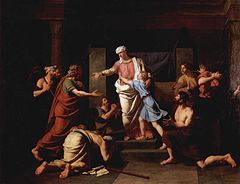
Charles Thévenin
Encyclopedia
Charles Thévenin was a neoclassical
French painter, known for heroic scenes from the time of the French Revolution
and First French Empire
.
 Son of a court architect, Charles studied painting at the Académie royale de peinture et de sculpture under François-André Vincent
Son of a court architect, Charles studied painting at the Académie royale de peinture et de sculpture under François-André Vincent
. Winning second prize in the prix de Rome
for Joseph recognised by his brothers in 1789, he won first prize in 1791 for Regulus returns to Carthage. Thus he received his first commissions and in 1790 produced the first version of The Taking of the Bastille, which produced a number of commentaries. He received a second prize at the Concours of Year II for The 12 July 1789.
After giving up history painting for decorative subjects for a time, in 1798 he produced Augereau on the bridge at Arcole, the first in a series of paintings glorifying the Empire. He left for Italy
, staying at the French Academy in Rome
, meeting Dominique Ingres and becoming the Academy's director from 1816 to 1823. On his return to Paris, he was elected a member of the Académie des Beaux-Arts
in 1825, then named Conservateur of the Cabinet des estampes in the Bibliothèque nationale
.
Neoclassicism
Neoclassicism is the name given to Western movements in the decorative and visual arts, literature, theatre, music, and architecture that draw inspiration from the "classical" art and culture of Ancient Greece or Ancient Rome...
French painter, known for heroic scenes from the time of the French Revolution
French Revolution
The French Revolution , sometimes distinguished as the 'Great French Revolution' , was a period of radical social and political upheaval in France and Europe. The absolute monarchy that had ruled France for centuries collapsed in three years...
and First French Empire
First French Empire
The First French Empire , also known as the Greater French Empire or Napoleonic Empire, was the empire of Napoleon I of France...
.
Life

François-André Vincent
François-André Vincent was a French neoclassical painter.He was the son of the miniaturist François-Elie Vincent and studied under Joseph-Marie Vien. He travelled to Rome, where he won the Prix de Rome in 1768...
. Winning second prize in the prix de Rome
Prix de Rome
The Prix de Rome was a scholarship for arts students, principally of painting, sculpture, and architecture. It was created, initially for painters and sculptors, in 1663 in France during the reign of Louis XIV. It was an annual bursary for promising artists having proved their talents by...
for Joseph recognised by his brothers in 1789, he won first prize in 1791 for Regulus returns to Carthage. Thus he received his first commissions and in 1790 produced the first version of The Taking of the Bastille, which produced a number of commentaries. He received a second prize at the Concours of Year II for The 12 July 1789.
After giving up history painting for decorative subjects for a time, in 1798 he produced Augereau on the bridge at Arcole, the first in a series of paintings glorifying the Empire. He left for Italy
Italy
Italy , officially the Italian Republic languages]] under the European Charter for Regional or Minority Languages. In each of these, Italy's official name is as follows:;;;;;;;;), is a unitary parliamentary republic in South-Central Europe. To the north it borders France, Switzerland, Austria and...
, staying at the French Academy in Rome
French Academy in Rome
The French Academy in Rome is an Academy located in the Villa Medici, within the Villa Borghese, on the Pincio in Rome, Italy.-History:...
, meeting Dominique Ingres and becoming the Academy's director from 1816 to 1823. On his return to Paris, he was elected a member of the Académie des Beaux-Arts
Académie des beaux-arts
The Académie des Beaux-Arts is a French learned society. It is one of the five academies of the Institut de France.It was created in 1795 as the merger of the:* Académie de peinture et de sculpture...
in 1825, then named Conservateur of the Cabinet des estampes in the Bibliothèque nationale
Bibliothèque nationale de France
The is the National Library of France, located in Paris. It is intended to be the repository of all that is published in France. The current president of the library is Bruno Racine.-History:...
.
Works
- Joseph reconnu par ses frères (1789). Musée des Beaux-Arts, Angers.
- Un vainqueur de la Bastille (1789). Musée Carnavalet, Paris.
- La Vengeance du peuple après la prise de la Bastille ou Assassinat du Marquis de Pelleport (1789–90). Musée Carnavalet, Paris.[1]
- Le Marquis de Launay, gouverneur de la Bastille, capturé par les assaillants le 14 juillet 1789 (1789–93). Musée Carnavalet, Paris.
- La Prise de la Bastille (eau-forte, 1790). Bibliothèque nationale de France, Paris.
- Régulus retourne à Carthage (1791). École Nationale Supérieure des Beaux-Arts, Paris.
- La Fête de la Fédération, le 14 juillet 1790, au Champ-de-Mars (1792). Musée Carnavalet, Paris.
- Œdipe et Antigone (v. 1795-96). Assemblée nationale, Paris.
- Augereau au pont d’Arcole, 15 novembre 1796 (1798). Musée national du Château de Versailles.
- Jean-Baptiste de Monet, Chevalier de Lamarck (1802–03).
- Abbaye de St. Martin de Sées (v. 1810).
- Reddition de la ville d’Ulm, le 20 octobre 1805, Napoléon Ier recevant la capitulation du général Mack (1815)

